Us Brits haven’t really had a lot of exposure to Cordovan compared to our friends over the pond. Many people over here still think it’s simply a colour of leather. I did a lot of research before purchasing my first pair of Cordovan shoes recently and I thought it would be good to share the information I compiled for those who are thinking about buying a pair. Below is what I regard as the essential knowledge for a first time buyer to be aware of. I’ll keep adding to this list anything further I find of interest and think might be useful as well as anything I experience with my own pair (especially in regards to the Comipel Cordovan). I’m happy to add anyone else’s comments, thoughts and experiences of Cordovan to this post in order to make a well rounded guide.
- THE SHELL: Cordovan is horse leather cut from the horse’s hind. Three pieces known as ‘shells’ are taken from each horse suitable for making shoes, hence one of the reasons Cordovan shoes are so expensive: one horse equals one pair of shoes (well, one and a half technically).
- CREATION AND COLOUR: The creation of Cordovan is a long, painstaking process over a period of six months. It’s a very difficult leather to colour as the dyeing is done by hand. A common complaint about Cordovan is often the poor colouration of the material, either from the outset (it may be uneven or patchy) or fading over time. The difficulty of the colouring however is no excuse for poor colouration upon purchase as Cordovan customers are charged a high premium for the material and should accept nothing less than perfect.
- LIMITATIONS: Cordovan is a tough and resilient leather, but due to its thickness it’s difficult to stitch and sew by hand and limits the amount of styles available in the material. For example the ‘beefroll’ on a beefroll penny loafer would prove too difficult to bend and sew for most shoe makers, thus making the style too hard to create.
- WEAR: Cordovan is softer, more pliable, and comfier than calfskin and it ripples rather than creases. Cordovan shoes require regular rotation and shouldn’t really be worn more than once before being given a rest. It’s worth keeping shoe trees in your Cordovan shoes in between wears.
- THE SHINE: The natural oils, fats and greases ‘stuffed’ and ‘curried’ in to the leather during the tanning process (as well as its generally thicker, oilier make up compared to that of calfskin) means that Cordovan naturally remains glossy and shiny without adding any polishes or creams. In fact to use anything such as this may actually ruin the surface and cover up its beauty. Buffing with a soft cloth and brushing with a stiff horsehair brush is all that should be needed to maintain the shine. A little polish paste spread very thinly over the shoe may be needed every once in a while.
- CLEANING: To clean, only a damp cloth should be used. I’ve heard rubbing Cordovan with a very slightly damp cloth and then buffing over and over (for 30 minutes or so) is also another great way to bring out the shine.
- SPEWING: White marks can form on new Cordovan at creasing points. This is called ‘spewing’. This is totally normal and can be wiped and buffed away.
- WATER: Despite being harder wearing and more water proof than calfskin, water can cause problems for the surface of Cordovan. Small ‘welts’ can appear where water has made contact. These are normal and should disappear when the leather is totally dry. If they don’t disappear the marks should come out with buffing and brushing. Persistent welts can be removed with the back of a teaspoon wrapped in a soft cloth.
- PRODUCERS: As mentioned in my M.T.O post, Horween (based in Chicago) is widely regarded as the best manufacturer of Shell Cordovan. They supply many of the finest shoe manufacturers with Cordovan, Alden being perhaps the most famous maker of Cordovan shoes with the Horween product. Many English shoe brands use Horween Shell Cordovan for their M.T.O shoes (and some R.T.W models) such as Alfred Sargeants and Crockett & Jones. Brits and Europeans can expect to pay a large premium for Horween however, which may explain why Tricker’s use Italian manufacturer Comipel to supply their Cordovan. My own Cordovan boots are Comipel Cordovan and I’m very happy with how they’re wearing so far. I’ve seen complaints that the surface isn’t as splendid as Horween and that it has a metallic odour. In my short experience I have not found this to be the case at all. The Mogano colour material looks to be every bit as nice (if not nicer) than some Colour 8 Alden’s I’ve seen in person and when compared side by side with Horween’s Whiskey Cordovan I would take Comipel’s Mogano everytime (however it’s only really fair to compare similar colours). Comipel’s colour range is more extensive and unusual than Horween’s, but Horween has the iconic Colour 8 which I think is the finest Cordovan colour of all. To the best of my knowledge Tricker’s do not and will not produce shoes in Horween Shell Cordovan.
- FIRST HAND EXPERIENCE: People have good and bad experiences with bench made shoes in any material. They are hand made products and are open to human inaccuracies. People are of course hyper critical when paying a higher price on rarer materials which is why Cordovan often comes under scrutiny. My advice would be to take as much as you can onboard from forums and blogs, but nothing beats handling the leathers in the flesh to decide for yourself if it’s worth the extra expense. Many people think not, but I fall on the other side and think it’s a leather with a shine like no other and worth having at least one pair of shoes in this special super-durable material.
- RAIN REACTIONS: I’ve noticed that a complete soaking in a heavy downpour is actually better for the leather than a brief splashing in a light shower. The reason being that when individual droplets hit the material they cause it to ‘welt’ (as previously noted). However, when it’s evenly soaked it swells evenly and dries smooth. An even soaking from a downpour yesterday has somewhat ‘reset’ the material and has gotten rid of any previous persistent ‘welts’. Finding this has put my mind at rest about one of my biggest concerns over Cordovan.
- COMIPEL VS HORWEEN: Now with a pair of shoes in Cordovan from both manufacturers I feel I can give a better comparison. Here’s some notes on the differences I’ve noticed between my pairs:
- Comipel is thinner than Horween’s product and has a definite difference when creased. Comipel ‘ripples’ much more than Horween Cordovan which has a sharper crease (whilst still not a crease like calf skin).
- The Comipel has an almost ‘satin’ finish to it whilst the Horween is pure gloss. The Horween leather on my particular pair far out shines the Comipel, although I think I’ve got a particularly shiny example of Alden Longwings. Some of the Color #8 Alden’s I tried on at Browns the other week had a pretty dull surface (duller than my Comipel’s infact). It goes to show it’s total swings and roundabouts. Choose wisely.
- Whilst not the same, the Color #8 Cordovan creases a lot lighter than the Comipel Mogano Brown (probably Comipel’s closest match).
- One thing I will say in favour of the Horween Cordovan is it’s much more evenly coloured. The Comipel Mogano Brown, although a slightly lighter colour is a little patchy.
- There has been very little difference in wet weather performance. Both have ‘welted’ in exactly the same way and frequency. The only way I really got rid of the welting on my Comipel leather was when it got saturated in a storm. The material swelled evenly and dried evenly to a dull finish. They shined up with a cloth and some elbow grease right back to normal. I would say (from a few wet weather performances) that the Horween leather retains its shine much more effectively. I need to buff the Comipel back every few wears (regardless of whether they get wet or not).
- In terms of the actual leather performance and wear I couldn’t make a clear decision between the two – for me it’s simply the iconic Color #8 that swings it in Horween’s direction in this comparison.
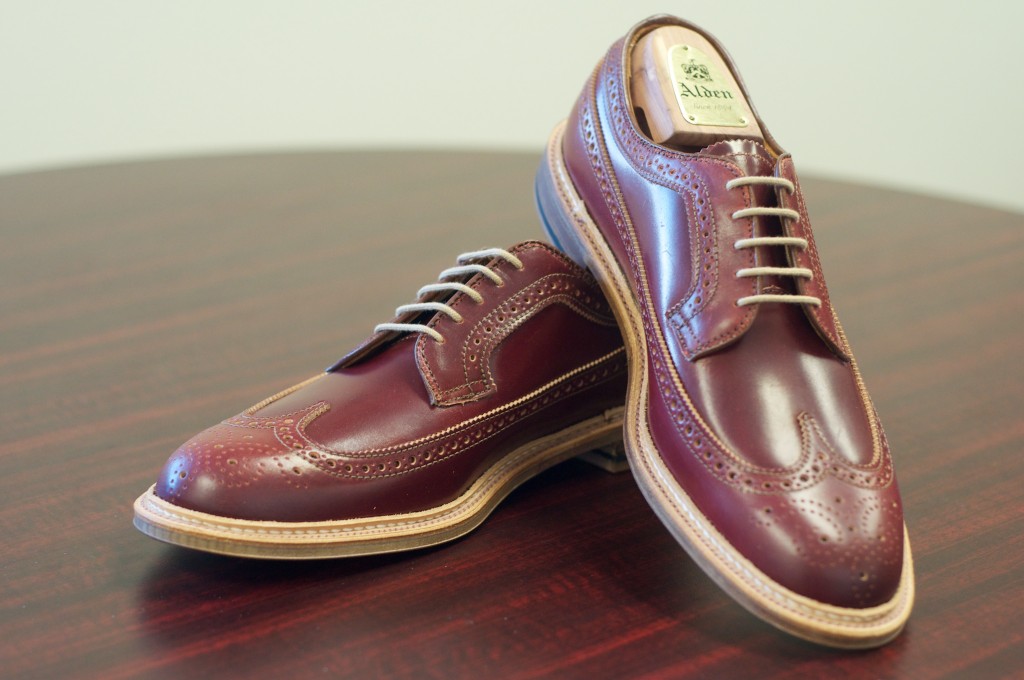
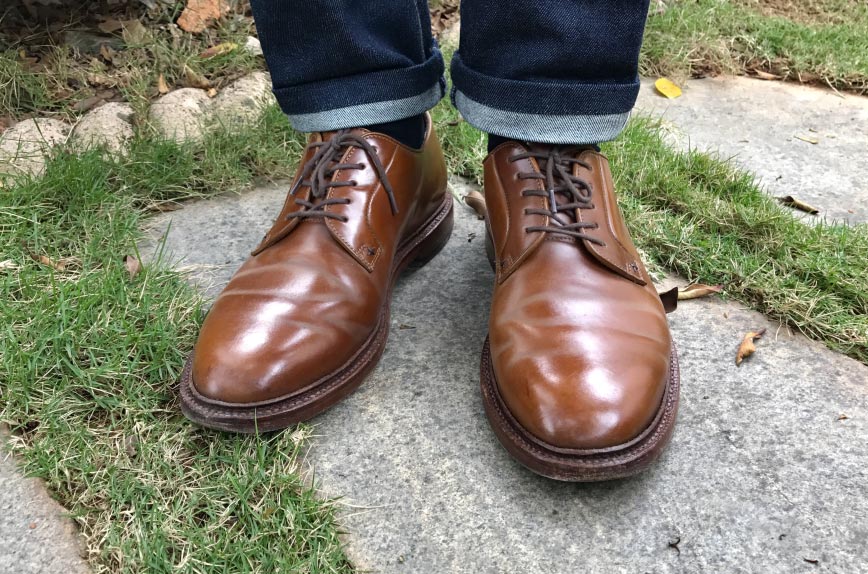
- A NOTE ON TRICKER’S USING HORWEEN. A couple of weeks ago I made an enquiry at Tricker’s Jermyn Street regarding a pair of MTO Short (5 hole) Stow Boots made in Horween Cordovan Color #8. Tricker’s informed me the DO NOT use Horween Cordovan. The reason they told me they gave it up was because they were not satisfied with the supply coming from Horween as not every piece was suitable for making shoes. They would however make a pair if I supplied the Horween Cordovan myself. The exercise would have proved too expensive and too big a risk considering Tricker’s reluctance to touch the stuff, so I gave up the enquiry. For those who would be interested you can buy Horween Cordovan direct from their UK agent A&A Crack (based in Northampton). The price to supply enough Cordovan for a pair of boots was around £170 (two pieces of Grade II Cordovan). I still might buy a piece myself as I’m interested in perhaps making a wallet out of it at some point.
- I found out an interesting fact about Color #8 during my visit to New York’s Leffot. Alden apparently stain their Color #8 a slightly ruddier colour than the original material Horween provide. Alden’s treatment also adds a glossier sheen to the leather. Having seen a few examples of the original Color #8 it is much closer to Comipel’s Mogano than I originally thought. This goes to explain some of the inconsistency I’ve witnessed between certain brands using this shade.
- Here’s a product I would recommend for maintaining your Cordovan: Saphir Médialle d’Or Renovateur
Some useful links
- A handy glossary of terms from Horween’s website.
- The tanning process at Horween:
- An informative video with some slightly random moments from Horween:


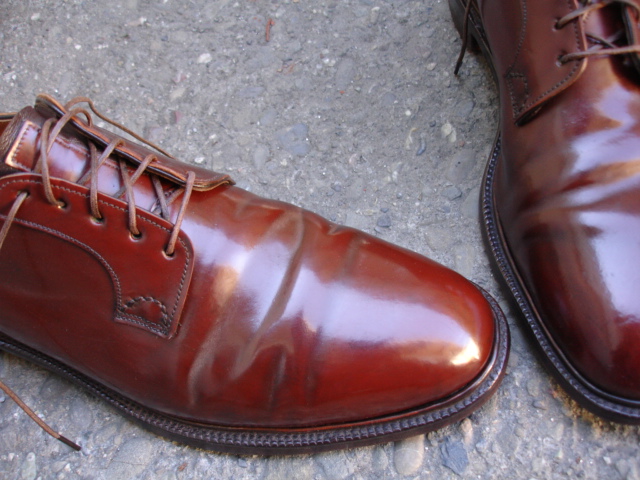
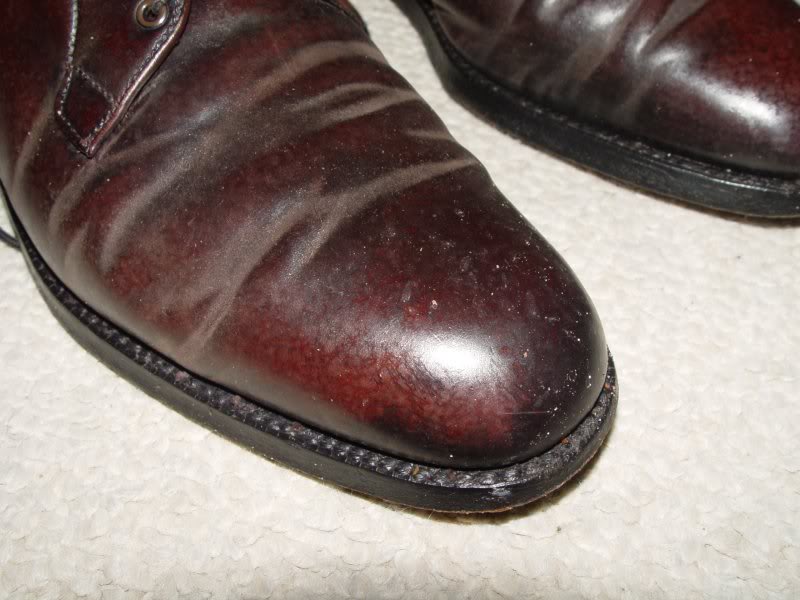
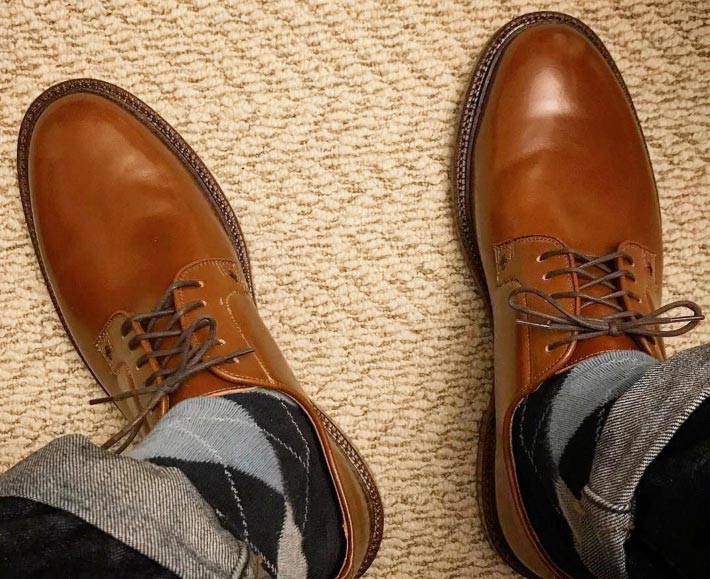
Thank you for the information. I however, Am not as concerned with esthetics…. I’m more so Concerned with durability . I have a question about the ripples and creases that I have in my shoes particularly the lighter color bourbon Carmina shell cordovan…. Whether or not the shell will eventually Split where those creases are. I take good care of the shoes and use shoe trees as well as wear them only once or twice a week with A-day or more in between. Thanks any knowledge or opinions would be appreciated